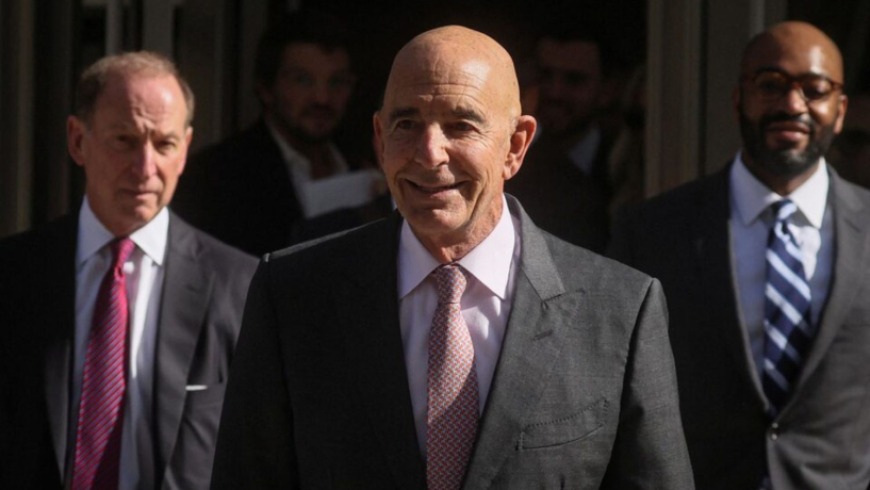Thomas Barrack, U.S. President Donald Trump’s special envoy to Syria, conducted a high-profile visit to the Israeli-occupied Golan Heights on Wednesday as part of his official trip to Israel. The visit underscores Washington’s growing focus on the evolving Syrian landscape and its implications for regional security.
According to Israel Hayom, Barrack toured strategic military sites in the Golan alongside Israeli Defense Minister Yisrael Katz, National Security Minister Ron Dermer, and senior Israeli military commanders. The U.S. envoy was reportedly briefed on current security dynamics in the area, with particular attention given to what Israeli officials described as “emerging threats from the new Syrian leadership” under President Ahmad al-Sharaa.
Barrack’s deputy, Morgan Ortagus, was also present during the visit, and the delegation is expected to continue its tour along the Israeli-Syrian border. The trip comes amid heightened tensions following recent Israeli air and artillery strikes on southern Syria, which Tel Aviv claims were in response to cross-border fire.
A Renewed U.S.–Israel Security Alignment
Israeli sources cited in the report emphasized that Barrack’s visit reflects enhanced U.S.–Israeli coordination, particularly in the face of Syria’s shifting political reality. Since the rise of Syria’s transitional government under al-Sharaa, Israeli officials have expressed growing concern over potential policy changes in Damascus, especially regarding Iran’s influence, border security, and Syria’s approach to Israel.
This is Barrack’s second major appearance in the region, following what was described as a “historic” trip to Damascus earlier this year—the first by a senior American official in over a decade. During that visit, he met with Syrian President Ahmad al-Sharaa at the People’s Palace and laid the groundwork for cautious diplomatic engagement.
Speaking to media outlets during his time in Israel, Barrack described the Syrian-Israeli relationship as “a solvable issue,” adding that “the path forward begins with dialogue.” He reiterated Washington’s commitment to facilitating a peaceful resolution as part of the Trump administration’s new regional strategy, which combines normalization efforts with calibrated containment.
Context: Strikes, Escalation, and Denials
Barrack’s visit comes just hours after Israel launched another round of airstrikes on southern Syria, targeting what it described as “weapons infrastructure” in response to reported rocket fire from Syrian territory. Artillery fire had also hit rural parts of Daraa province earlier in the day.
Damascus, however, disputes the Israeli narrative. In a statement released by the Syrian Foreign Ministry, officials said they have yet to confirm the rocket launches attributed to Syrian soil and condemned the Israeli strikes as a “blatant violation of Syrian sovereignty.” The ministry stressed that Syria “has not and will not be a threat to any party in the region,” and reaffirmed that its priority in the south remains reestablishing state authority and ending the presence of unauthorized arms outside official institutions.
The Road Ahead
Barrack’s presence in the Golan—and his continued engagement with both Israeli and Syrian leaders—signals a new chapter in American diplomacy toward the Syria-Israel file. Though no formal negotiations are underway, the envoy’s remarks suggest that Washington is laying the groundwork for a future dialogue process—one that may tie into broader regional realignments following the recent thaw in Syria’s Gulf relations.
With Trump expected to soon remove Syria from the U.S. list of “state sponsors of terrorism,” and both Doha and Riyadh deepening their engagement with Damascus, Barrack’s visit may mark a turning point in efforts to redefine the strategic calculus in the Levant.
Still, the situation remains fragile. The continued Israeli strikes, Syrian denials, and the uncertain trajectory of al-Sharaa’s foreign policy all leave room for miscalculation. In this complex environment, Barrack’s diplomacy could either open a channel for constructive engagement—or find itself navigating yet another Middle Eastern fault line.
This article was translated and edited by The Syrian Observer. The Syrian Observer has not verified the content of this story. Responsibility for the information and views set out in this article lies entirely with the author.


